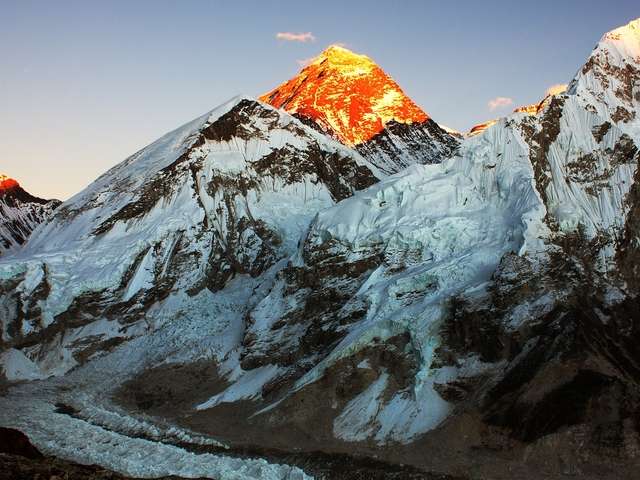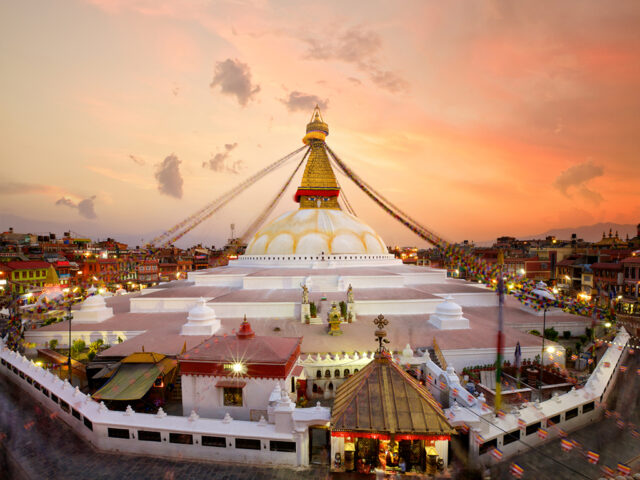
Home to the world’s highest mountains, most visitors to Nepal head straight for the Himalayas. While it’s undoubtedly one of the world’s greatest trekking destinations, it would be ridiculous to assume that all Nepal has to offer is the Himalayas. It’s a country with an incredibly diverse and rich history; a lavish tapestry of interwoven cultures, vibrant colors and experiences. Here the opportunities for adventure abound, safari through tropical forests in search of rhinos and tigers, visit the world’s holiest pilgrimage sites, or paraglide over turquoise lakes. The possibilities are endless.
Wildlife & Safari
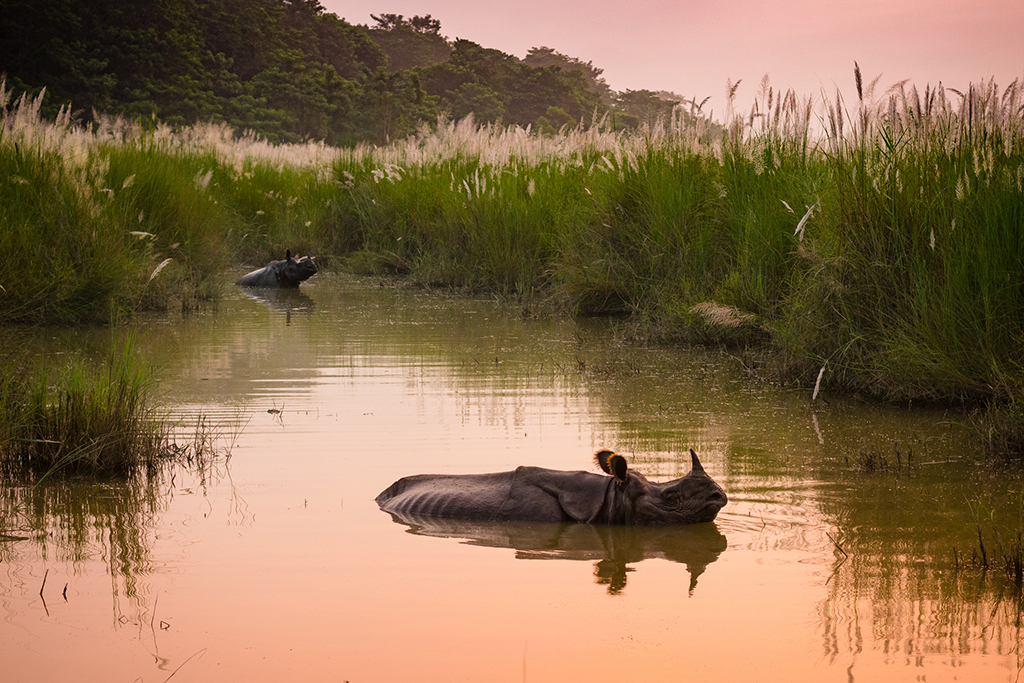
1. Chitwan National Park
Pristine, gorgeous Royal Chitwan National Park is a UNESCO World Heritage Site and one of Nepal’s jewels. Nepal’s oldest national park offers tropical tea gardens, safaris, bird watching, and rafting. The biggest draw are the park’s (elusive) tigers and its mudhole adoring one horned rhinos. Canoe the Rapti River to get an up close encounter with crocodiles while spotting elegant egrets and striking kingfishers. In addition to it being a fantastic safari destination, all the tourism supports the park’s conservation efforts so you’re investing your money in Nepal’s unique wildlife and habitat. Visit from February- April or November-January for the dry weather that draws the animals out of the jungle to access the watering holes.
Check out: 3 Day Chitwan Safari
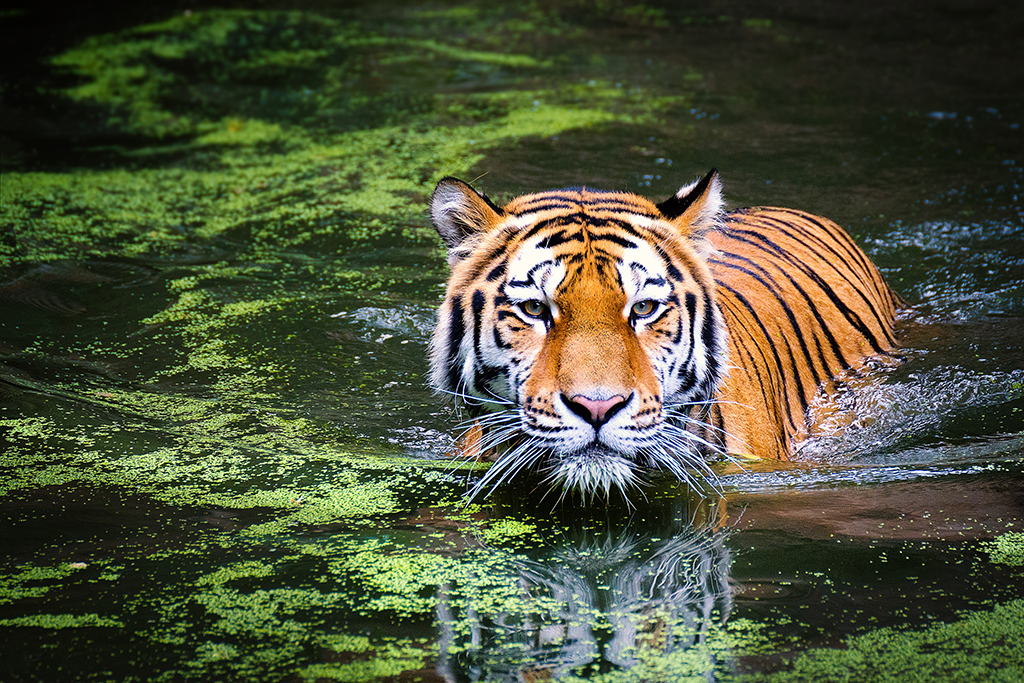
2. Bardia National Park
Nepal’s second biggest national park is also famous for One-horned rhinoceros and Bengal tigers as well as incredible birdwatching. This park, located in western Nepal, is isolated and off the beaten path making it Nepal’s most authentic wildlife parks. With less visitors than Chitwan National park and denser, undisturbed forests you’re more likely to spot a Royal Bengal tiger here than anywhere else in the country. Your best chance seeing one of the park’s 60+ tigers is on a walking safari during September-November. If you don’t catch a lucky break and spot one, it’s still possible to spot leopards, monkeys, deer, wild peacocks, kingfishers, crocodiles and elephants in the park. Also consider taking a rafting tour, where you might spot the rare gharial crocodile or the Gangetic river dolphin.
Cultural & Pilgrimage
3. Muktinath Temple
Revered by Buddhists and Hindus alike, Muktinanth Temple is alive with local legend and spiritual lore. Situated at the foot of Mt.Dhaulagiri in the Annapurna range, Muktinanth lies in a high altitude desert region, at the base of Thorong La Pass. A religious pilgrimage is often undertaken to visit this holy site where its 108 waterspouts are believed to wash away sins. This isolated corner of Nepal preserves Tibetan culture while hiding rich cultural jewels such as ancient monasteries with mystical flames, multistoried pagodas and Buddhist cave paintings. Among the picturesque terrain lies a plentitude of sacred chortens, gompas, and stunning traditional villages. It’s beautifully remote, undisturbed and one of our favorite destinations in the Annapurna Circuit.
See Our: Upper Mustang Trek
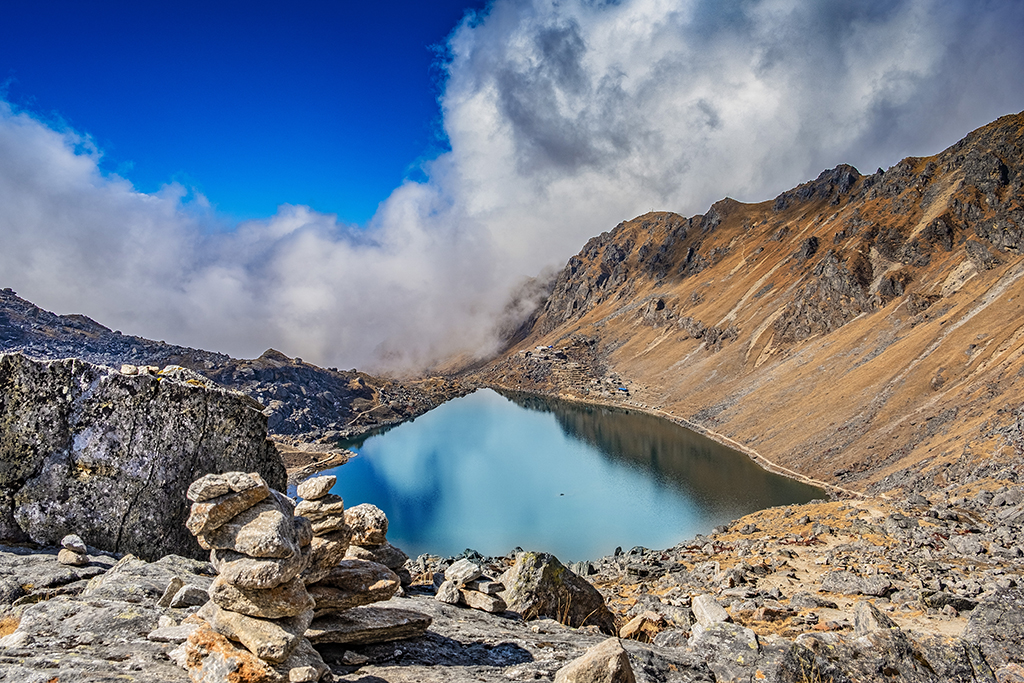
4. Gosainkunda Lakes
To reach the Lakes of Gosaikunda one must be prepared for high altitude trekking through the lush forests of Langtang National Park. Though difficult to reach (at 4360 m), to see the radiant lake of unparalleled importance to both Buddhists and Hindus is doubtlessly rewarding. It is believed that to bathe in this sacred lake washes away one’s sins and sorrows. The biggest pilgrimage takes place in August when Hindus flock to the site to celebrate Janai Purnima. Be sure to take in views of Annapurna in the distance while enjoying the local flora and fauna, such as rhododendrons and red pandas. Pass by the region’s 108 glacial lakes while staying in quaint tea houses for a classically beautiful Nepalese trek.
Read: 7 Great Reasons to Choose The Langtang Trek
5. Lumbini
Fill your heart with tranquility while admiring the lush, manicured grounds of the Maya Devi Temple, the birthplace of Buddha. It is one of the most important Buddhist pilgrimage sites and receives millions of tourists each year. Visiting the ruins of these ancient monasteries is a spiritual experience that will instill you with reverence and peace. From dawn until dusk, monks and pilgrims from all over chant, meditate, and light incense under the sacred Bodhi tree across from an ancient bathing pond. Take an afternoon to discover all the pavilions, golden shrines, the Asokan pillar and the lanterns and the thousands of prayer flags that decorate the auspicious site. Be aware that upon entering the Maya Devi Temple no shoes or photography is allowed.
Kathmandu Valley
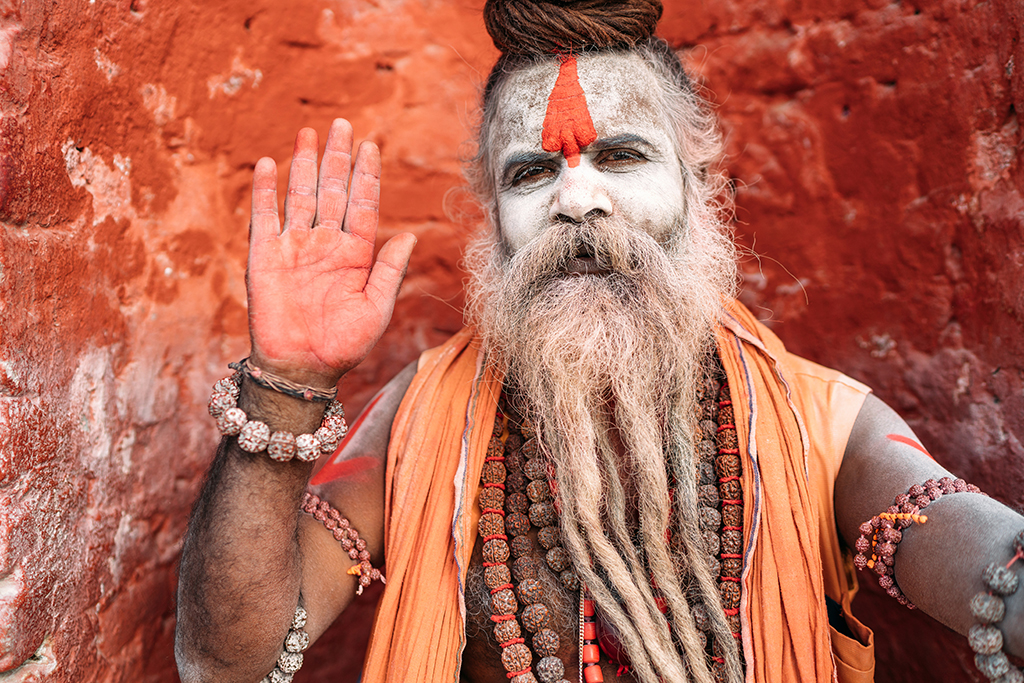
6. Pashupatinath Temple
In the Eastern part of Kathmandu Valley lies the Pashupatinath Temple, Nepal’s most sacred Hindu temple. This precinct is a myriad of Hindu temples built along the banks of the Bagmati River, considered holy since it eventually flows into the Ganges River. Dating back to around 400 AD these Hindu temples were uniquely built in a pagoda style of architecture that originates from the Newar culture of Kathmandu Valley. The river is lined with a series of funeral Ghats where daily cremation ceremonies, involving marigold chains, wooden pyres and large crowds of mourners, take place. Wandering through the temple complex you are likely to encounter some of the old Sadhus (wise men) wearing orange robes and spiritual beads. They often grow their hair for years and forsake all of modern day luxuries in their search for spiritual enlightenment. With permission and sometimes a small donation the Sadhus will give you a blessing or sit for a photo.
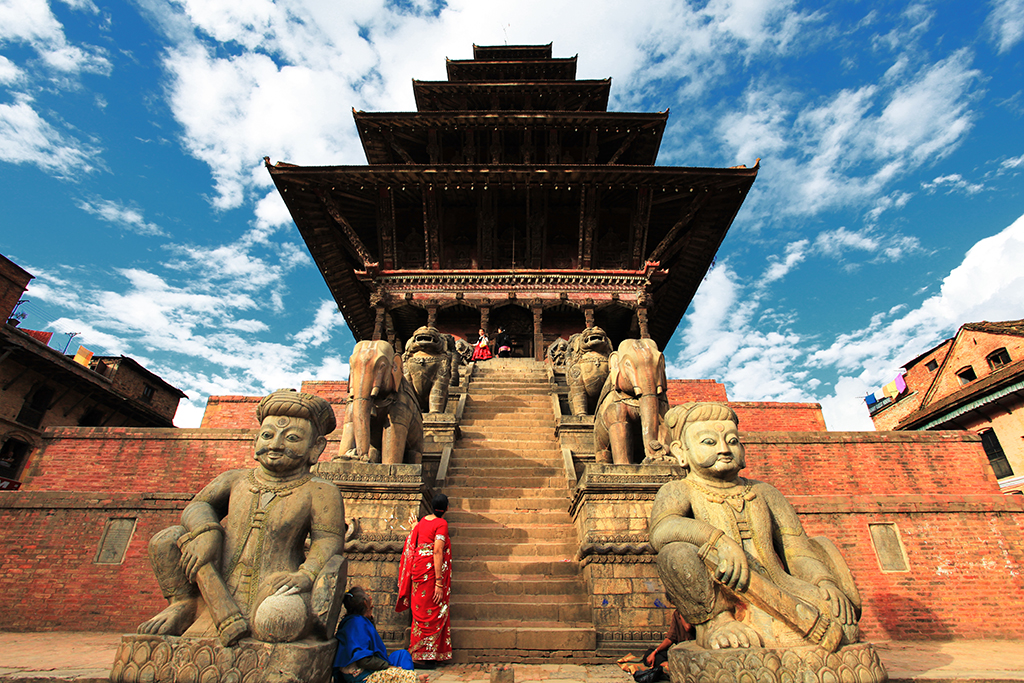
7. Bhaktapur Durbar Square
“The city of culture” is one of the three historic cities of Kathmandu Valley dating back to the 15th century. This ancient city is famous for its intricate architecture, delicately carved wooden windows, multi-tiered pagodas and sunken wells. The most famous of these Newar windows is the Peacock Window, also known as the “Mona Lisa” of Nepal. Bhaktapur is also home to Nepal’s tallest temple, the Nyatapola Temple, as well as the famous 55 Window Palace. Wander medieval royal courtyards while examining the expert craftsmanship of the fountains, golden gates, and sculptures of the guardian animals in the city. There are countless fascinating alleys and winding roads to get lost in. Be sure to sample some of the Newar cuisine at one of the local rooftop restaurants.

8. Swayambhunath/Monkey Temple
Sure to be one of your favorite places to visit in Kathmandu, the Swayambhunath temple is a vibrant hilltop paradise completely worth taking the 365 steps to get to the top (plus it will help you burn off some of the momos). Sacred to both Hindus and Buddhists, it has been a site of religious harmony and faith over 2000 years old. Living up to its name, the temple grounds are alive with sacred monkeys chasing after one another or swimming in the pool near the temple. Perched atop the Northwest corner of the valley hugged by forest and overlooking the city, it’s a beautiful place to enjoy the sunrise. The main temple is a brilliant white dome topped by a golden spire and Buddha’s all seeing eyes. While you’re there enjoy spinning the site’s many prayer wheels (always clockwise), take photos of the prayer flags swirling out into every direction or get a blessing from a local. It’s one of Kathmandu’s most beautiful locations so be sure not to miss it!
9. Boudananth Stupa
The ancient Stupa is one of the most important for Tibetan Buddhists and thousands of Buddhists flock to it annually. Nepal’s largest stupa, and one of the largest stupas in the world, is 100 meters in diameter and 40 meters in height. This massive temple is colorfully decorated with prayer flags and it stands as a symbol of unity, compassion, wisdom and enlightenment to the world. Every aspect of Boudananth has parabolic significance. Its large, white dome represents the earth whose base is surrounded by prayer wheels and on the top is a cubicle structure with paintings of the eyes of Buddah. The 13 spires surrounding the cube represent the 13 tasks the Buddhists must perform to reach enlightenment. Around this peaceful sanctuary you will find many monks, ayurvedic shops and rooftop restaurants with breathtaking stupa views. Enjoy the chirping of birds mixed with traditional Tibetan music while you leisurely circumambulate this quintessential Buddhist monument.
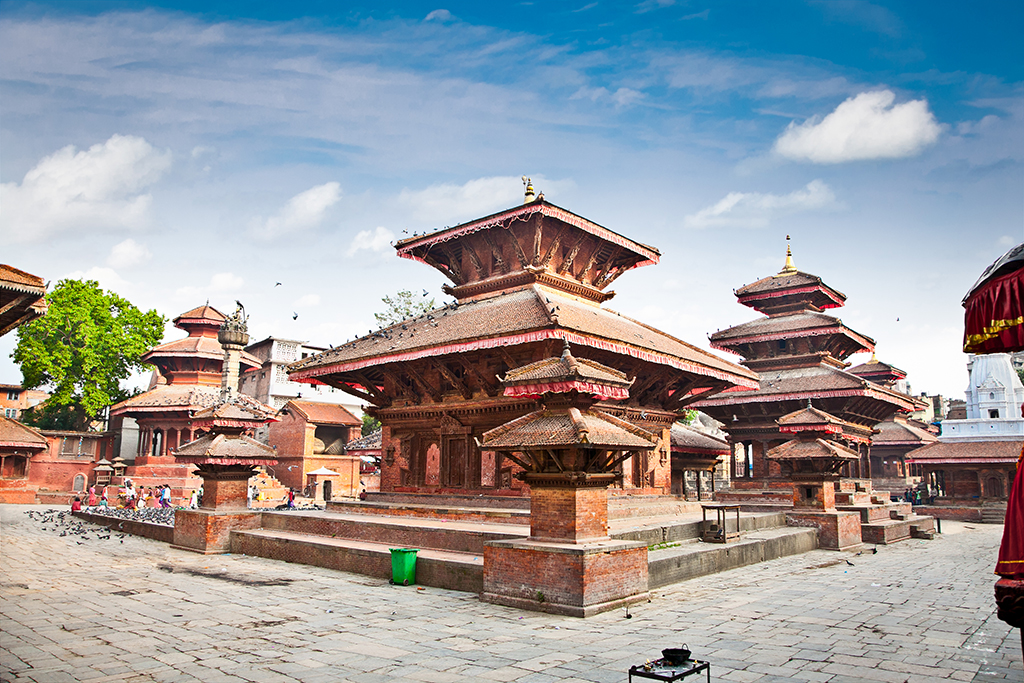
10. Kathmandu Durbar Square
The Durbar Square of Kathmandu is one of the most interesting places in Thamel both architecturally and culturally. Magnificent shrines, Hindu and Buddhist alike, are spread throughout the extravagant 15th Century square. Due to there being over 50 grandiose temples and red, frilled multi-tiered pagodas in the center of the old city, it is nicknamed the “museum of temples”. Historically the royal palaces of the Malla kings, the atmospheric square’s architectural highlights include ornate Newar windows and exotic wooden carvings. It’s a popular place to buy hand-carved souvenirs and to watch the locals feeding pigeons. Include a visit to the big brick Kumari Ghar, where the living goddess Kumari lives and can be seen through her window at select hours. It is also the location of the Indra Jatra celebration, one of Kathmandu’s most epic festivals.
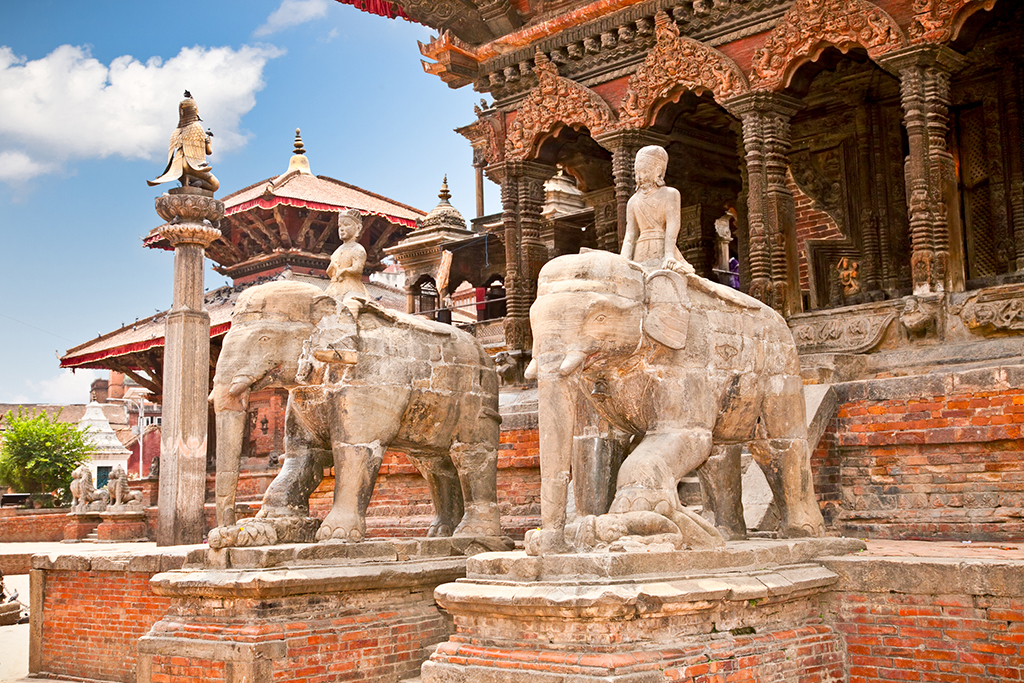
11. Patan Durbar Square
It is the most Buddhist of Kathmandu Valley’s three ancient cities, while Bhaktapur is the most Hindu and Kathmandu somewhere in the middle. In Patan there are 55 major temples and 136 monasteries, made of wood, stone and even terracotta. One of the highlights in Patan is the Durbar square, which has been given the status of world heritage site. All of the temples and palaces that surround the main square are constructed in the Newar style which is typified by its delicate engravings and multi-storied pagodas. On the West side of the square resides Krishna Mandir, a majestic stone temple from the 17th century that’s also the most important Krishna shrine in the valley. Lastly, check out the Patan Museum within the palace to see the breathtaking metal work, wood carvings and other pieces of fine sculpture.
12. Nagarkot
Nagarkot is a peaceful village on the fringes of Kathmandu Valley perfect for those seeking to retreat into nature. Just under a two hour drive, Naharkot offers an insight into rural Nepalese life and has fantastic views of six of the world’s highest mountain peaks. Its rise in popularity is in part for its amazing sunrises and sunsets in the Northeast behind Everest. During your stay hike through rhododendron forests to the tower of Nagarkot for great views into the valley or visit the Buddha Peace Park to meditate or plant a tree. For an immersive cultural experience, hike east to the town from Kathmandu, breathing in the pines, terraces and sleepy farmhouses of the region. For the clearest views of the Himalayas, visit from October to December or from March to April. Also, consider visiting Nagarkot (2,195 m) before a high altitude trek to improve your acclimatization!
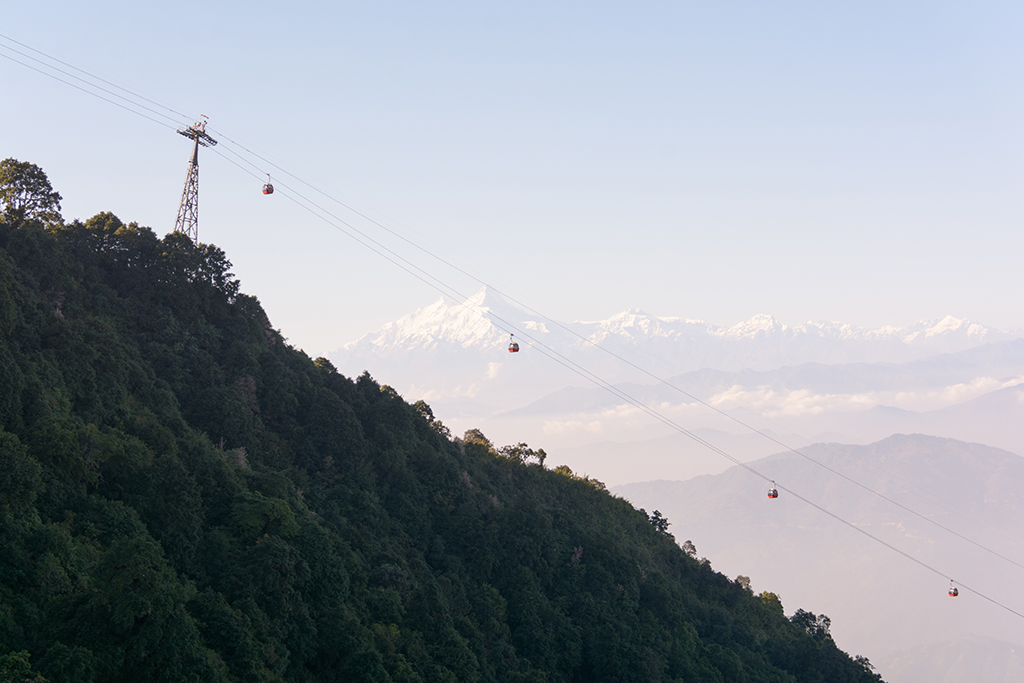
13. Chandragiri Cable Car
Just 45 minutes outside of Kathmandu, a short, beautiful gondola ride takes you above the clouds in the valley and away from the busy city. On a clear day there are mesmerizing Himalayan views to the west offering you a glimpse of the world’s tallest mountain, Everest. In addition to the spectacular views, Chandragiri is also a historical site where the first monarch of the Kingdom of Nepal first saw Kathmandu Valley. He meditated there for the powers to unify the country which he later did. After enjoying the peace, fresh air and solitude of the hilltop, consider visiting the small Hindu temple there to petition Bhaleshwar to grant your wishes. Visiting Chandragiri should only take half a day and the panoramic views of the Himalayas completely make it worthwhile.
Around Pokhara
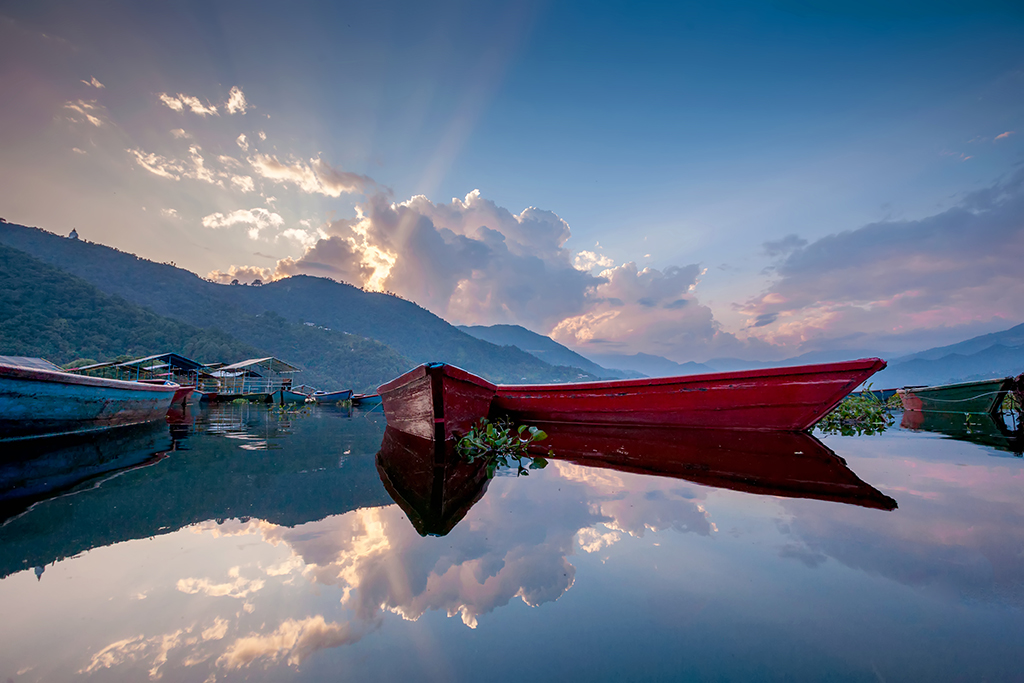
14. Phewa Lake, Pokhara
Phewa Lake is a beautiful freshwater lake that reflects the stunning peaks of the Annapurna region. Walking its beautiful shoreline is one of the highlights of visiting Pokhara, one of Nepal’s most picturesque towns. To fully appreciate the lake consider paddling one of the many colorful canoes out onto its blue green waters or hire a local to row you around. Make sure to visit the beautiful island temple of Durga (a Hindu deity of feminine power) canopied by verdant, green trees. Other popular lakeside activities include sailing, fishing and swimming or eating a relaxing meal at one of the many lakeside restaurants. October offers the best visibility of the snow capped mountains with lustrous forested valley ridges. On the clearest days the lake acts as a mirror, reflecting the fishtailed summit of Macchapucchre (6,993m) in a glowing double photo that is as magical as it is surreal.

15. World Peace Pagoda
Sitting at an altitude of 3,608 feet, the World Peace Pagoda surrounded by blooming gardens is a sight to behold. Adding on the spectacular views of Phewa lake below and the panoramic views of the Annapurna range and Pokhara, you will be instilled with peace and harmony. It’s no surprise that this brilliantly white stupa is an extremely popular landmark. One of 80 peace pagodas built by Japanese monks inspired by Gandhi, the pagoda is meant to unite all peoples to search for peace. Though it’s also possible to take a taxi to the top, the 300m hike to the Peace Pagoda is reasonable and worth every step. As with most Himalayan encircled destinations, the stupa crowned summit is especially dazzling at sunrise and sunset.
Short Adventures
16. Trishuli River Rafting
Three hours outside of Kathmandu is the Trishuli River, Nepal’s most popular rafting destination. Fed with snow melt from the Himalayas, this wild river rushes through amazing mountain scenery, verdant rolling hills, lowland jungles and impressive gorges. The swift white water rapids will thrill you with big drops as you hold tightly to your raft. Take in Nepal’s natural beauty and unique sights as you pass by monkeys, traditional villages and local fishermen on the shore. Take breaks from paddling to cliff jump and swim through the cool river waters. End each night listen to Nepali music around a campfire or stargaze on a soft, sandy beach before falling asleep in your bamboo hut. If this adventure leaves you wanting more, consider taking a canyoning trip in the area for the excitement of rappelling and cliff jumping down waterfalls.
17. Bungy Jumping
Imagine this. A bridge 160 meters (520 ft) over a tropical canyon with a river raging below you. You will be snugly strapped into the harness while your heart and mind race with adrenaline. With your ankles securely strapped together you waddle towards the inconceivably ungated ledge when it’s your turn. Try to breath. Don’t look down. You try to smile for the camera but your eyes widen as you fall. You’re tingling and feel dizzy and off the ledge you go. Wind ripping at your clothes. Nothing between you and the river far below. Swan diving to the earth, no thoughts in your head as the ground is approaching FAST. But, seemingly at the last second, the bungy gently pulls you up against the gravitational forces at both your feet and waist. The rush of blood to your head eases as you bounce up before you drop towards the rapids again. As the bouncing ebs you are filled with elation in its purest form. You can’t help but beam from ear to ear. Congratulations, you’ve just bungyed off the second highest bungy jump site in the world.

18. Paragliding in Pokhara
By now you’ve certainly realized that Nepal is one of the top adventure destinations in Asia, and one of the best ways to explore it is by air. If you’ve ever considered jumping off a cliff, Pokhara is one of the best places to do it! It has stable thermals, innumerable safe landing and take off options in addition to the jaw dropping views of Dhaulagiri, Annapurna, and Manaslu (three of the world’s highest mountains, all over 8000m). The season for paragliding in Nepal is the same as the trekking season; from September to November and February to March the thermals are active and the flying is easy. Adrenaline junkies should ask their pilots to do acro (loops and turns) as they are no extra charge!
Trekking Spots
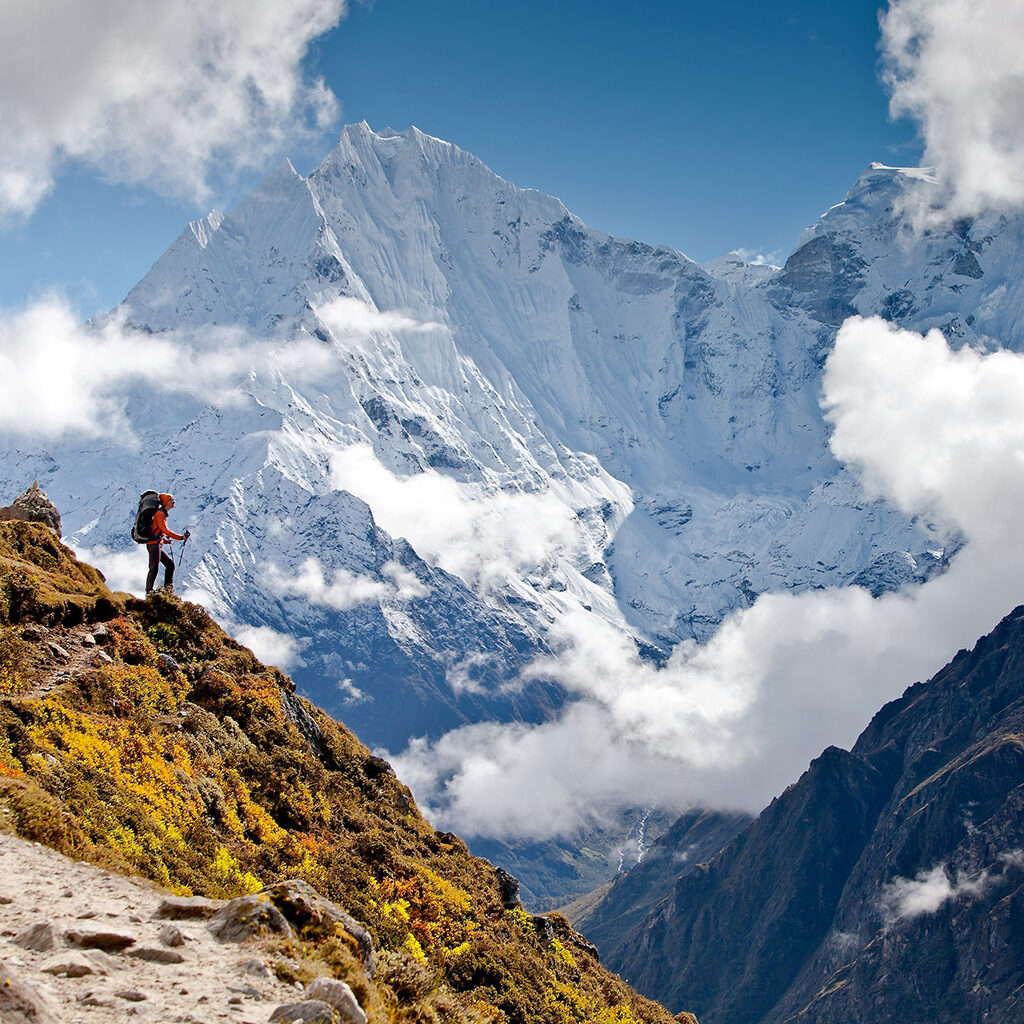
19. Everest Base Camp
It turns out that every trekker’s ‘dream trek’ is also our all time favorite trek in the Himalayas. From the first day the excitement is tangible and the views of the world’s tallest mountains are immediate. The locals are friendly and accommodating, never without a smile on their face. Experience the best of tea house trekking on this 11 day trek. The trail ends at Everest Base Camp where you can look directly up the ice fall of the Khumbu Glacier towards the peak of Everest which is still an impressive 3500m above you. You will see 3 of the world’s 10 tallest peaks: Everest, Cho Oyu (8201m/26,906ft) and Lhotse (8,516m/27,940ft). Just as spectacular although not as tall are the diamond shaped Pumori (7,161m/23,494ft) and the crowd pleasing “Matterhorn of the Himalayas” Ama Dablam (6,812m/22,349ft). Trek from September to June for pristine conditions or December and January for cooler temperatures and solitude.
See Our: Trek to Everest Base Camp
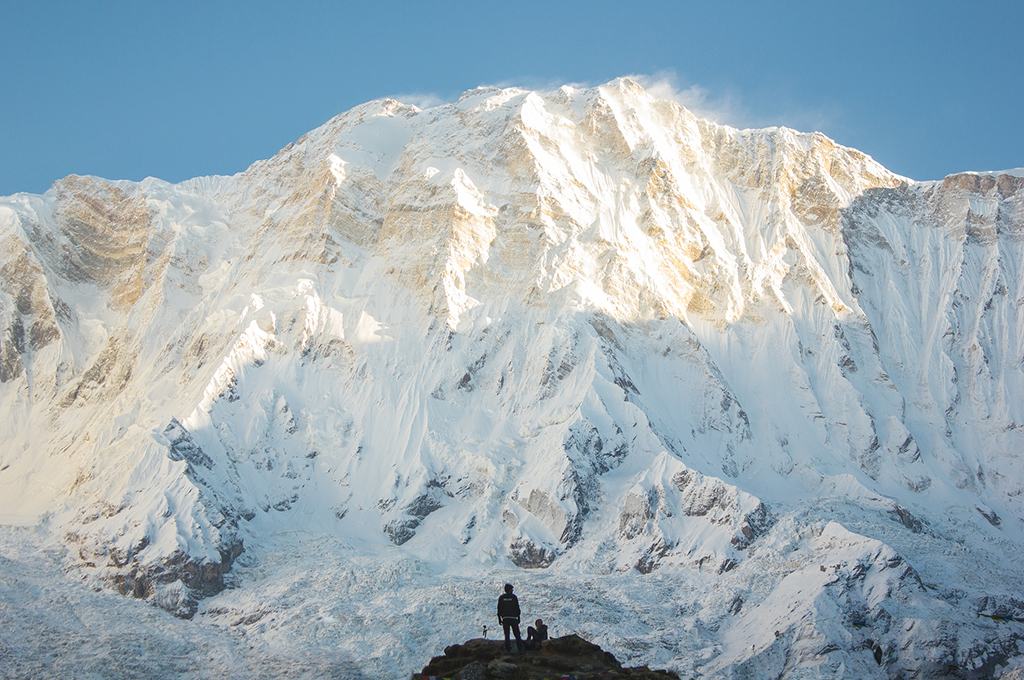
20. Annapurna Sanctuary
The breathtaking scenery and awe-inspiring wonders of the Annapurna Sanctuary is best explored on the Annapurna Base Camp Trek or Circuit. The treks pass through a variety of landscapes ranging from rich farming valleys to the stark high altitude desert region of Mustang. Tea houses and lodges are available throughout the entire length of the trek and offer cozy accommodation and scrumptious local meals. There are also fantastic close-up views of some of the world’s tallest mountains – Dhaulagiri, Manaslu, Gangapurna and Tilicho Peak. From Annapurna Base Camp, there are arresting views of the shimmering south face of Annapurna I – the world’s 10th-tallest peak! The region also offers heavenly glimpses of Machapuchare (Fishtail), which is revered as sacred to the god Shiva, dotted by glaciers and limned in a sheer cliff face. The trek is generally possible throughout the year but heavy snowfall can block the Thorung La Pass at times in January and February.
21. Langtang Valley
Easily accessible from Kathmandu, the Langtang trek is a short trek (6 to 9 days) that combines fantastic mountain views and excellent tea house accommodation. On the way, you will pass delightful farming villages with orderly terraced fields hugging the mountain sides. The region is famous for its cheese factory that produces fresh yak curd and high elevation cheeses so be sure to give those a taste. Once you’ve stocked up on cheese, visit the centuries old Tibetan monastery and Gompa, which are the most spiritual landmarks in the area. If you are trekking the region in the springtime, prepare for an explosion of bright red blooming rhododendron forests. If you’d like to see fantastic views of the surrounding peaks then spend a day climbing either Kyanjin Ri or Tsergo Ri…But make sure to keep an eye out for the yetis.
22. Manang
A few days into the Annapurna Circuit Trek is a hidden gem: Manang Valley and the side trek to the stunning Tilicho Lake, one of the highest lakes in the world. Travelers come from all over the world to hike its long distance treks and see the colorful festivals. Manang has some of the Himalaya’s most beautiful features such as Thorong La Pass and regional hot springs. The region is unofficially split along cultural lines with Upper Manang being highly influenced by Tibetan culture and lower Manang more influenced by the lower surrounding Nepali culture of Lamjung. It’s an underrated and remote destination in a pristine region of the Himalayas that you’re sure to fall in love with.
Nepal offers a spectacular array of things to do from rare wildlife excursions to world class trekking and river rafting. It has something for everyone, whether you be a connoisseur of fine architecture or an adrenaline junkie looking for your next thrill. Join us in the mystical country of Buddha’s birthplace, filled with ancient cities and even more ancient traditions. Contact us today to see why this little landlocked mountain country is one of the most popular destinations in Asia.








